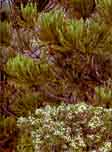 Neocallitropsis pancheri. Formerly exploited for its fragrant, decay-resistant wood. Stands are now rare and threatened. In the foreground, Boronella verticillata (3). | Neocallitropsis pancheri Common NamesTaxonomic notesSyn: N. araucarioides (Compton) Florin (1); Callitropsis araucarioides Compton (2). The sole species in Neocallitropsis Florin 1931 (syn: Callitropsis Compton (2)).Description"A tree of conical habit, [9-11 m] high, with an erect trunk and greyish bark, resinous in all its parts. Branches horizontal. Branchlets cylindrical, fastigiate, forked, resembling those of an Araucaria. Leaves regularly arranged in 8 vertical rows, stiff, incurved, about [6 mm] long, [5 mm] wide, short-pointed, strongly keeled on the back, margin minutely toothed. Male strobili ovoid, [12 mm] long, [6 mm] across, terminating the long branchlets, consisting of sessile pollen sacs borne on the bracts, which are arranged in about 8 rows, like the leaves. Cones terminating short, lateral branches, consisting of 8 scales in 2 whorls of 4 each, separating at maturity and forming a cup-like involucre from which the ripe seeds are scattered. Seeds angular, scarcely winged. Cotyledons, 2" (2).RangeS New Caledonia: Yate Dam, Plaine des Lacs to Prony, 150-950m (1) on serpentine (2).Big TreeOldestDendrochronologyEthnobotanyObservationsRemarksThe genus name is derived from the species' resemblance to Callitris (2).Citations(1) Silba 1986.(2) Dallimore & Jackson 1967 (as N. araucarioides). (3) Schmid 1981. See also: |
[Neocallitropsis] [Cupressaceae] [home] This page is from the Gymnosperm Database |